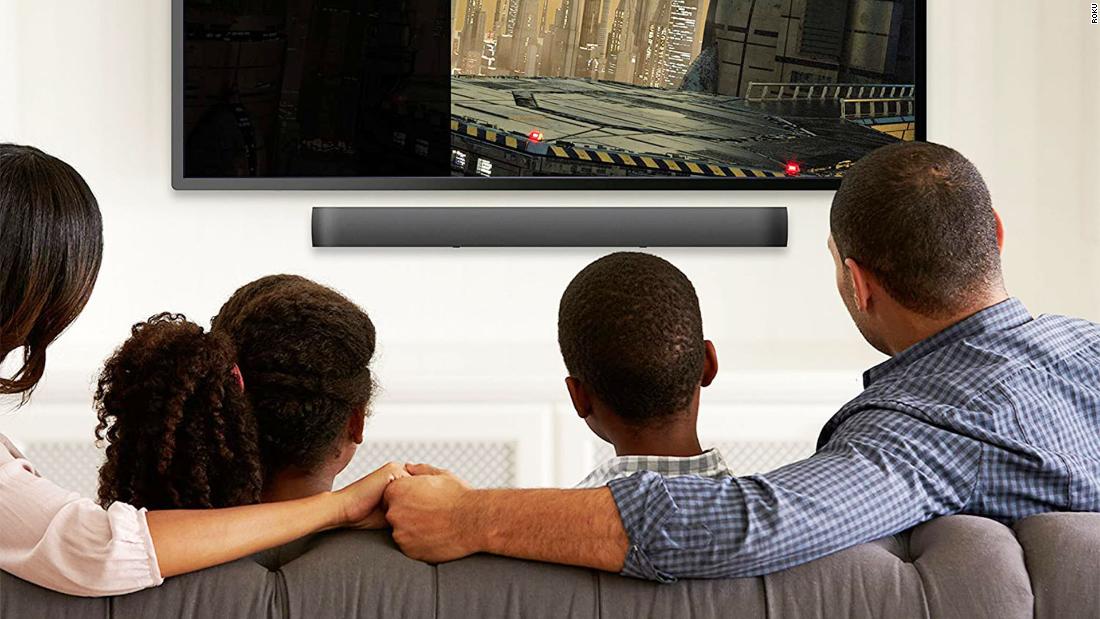(CNN) —
As TVs slim down, picture quality keeps getting better while built-in audio continues to deteriorate. That’s why, as we note in our best TVs guide, it makes sense to pair your TV — even a brand-new model — with a soundbar.
Sure, you could wire a few different speakers up around the room. But the all-in-one solution of a soundbar is the simplest way to boost your audio experience. Plus, soundbars today rival the output of surround-sound systems. What’s more: You don’t have to spend a small fortune to get a quality soundbar. Many soundbars in the $150 to $350 price range proved to deliver a surround-sound-like experience. But, of course, if you’re willing to spend more, you’ll get a herculean audio experience.
Over the course of six months, we tested 14 soundbars. We binged more TV series than we’d like to admit, gamed until our thumbs were calloused and listened to our fair share of audio content (from Broadway shows to podcasts). All the while, we compared audio quality across the board while also noting built-in smarts and ease of use. In the end, we found two soundbars that stood out from the rest:
The Smart Soundbar from Roku, at just $179.99, is a combo soundbar and 4K streaming box that boasts four speakers that don’t just up the volume but also deliver clear audio that makes whatever you’re watching sound great. While it didn’t feature the best sound quality of the soundbars we tested, you would have to spend more than double the price to get something more than nominally better. Pushing it to the top, though, were its smarts — including Bluetooth, Apple AirPlay 2 and multiple audio modes — that rivaled some $1,000 soundbars. Throw in the fact that its compact and nondescript build is far less distracting than others, while also providing easy pairing with devices to play audio however you like, and its value becomes somewhat mind-boggling.
The Roku will suffice in most use cases, but if you’re looking to get the best, near-theater-like audio quality from a soundbar, then the $799 Sonos Arc is your best option. Its 11 speakers are all angled differently to push audio out in various directions, so rather than sound coming out in one wave it flows throughout the room to deliver a surround-sound feel. The Arc also boasts more bass than any other soundbar we tested, but one that doesn’t overwhelm any high or mid tones. Most impressively, TruePlay — which you can find out more about below — maps the room to deliver the best sound mix. At $799, it’s not the most affordable, but it tops all other soundbars in terms of pure audio chops — and can even put up a fight with most home theater systems.
Roku may have cut its teeth in the streaming game, but the brand has been making waves in the audio world since it first entered in 2018. With only its second audio product, the Smart Soundbar, Roku is raising, er, the bar.
The Roku Smart Soundbar was incredibly easy to set up. There aren’t a ton of ports on the back, leading one to waste time trying to decipher which wire plugs into which port. You only get power, HDMI out, optical and a USB-A (the larger ports that have long been the standard). Roku includes an HDMI cable, and we recommend connecting to the HDMI eARC port on your TV if you have one. This will allow the Roku remote to control the sound for your TV with ease. And, since this soundbar is also a Roku streaming box, it’s the key to controlling the system.
The plastic build, enveloped by soft mesh on the front, lacks a certain flair. But, truth be told, we appreciated that, as the Smart Soundbar doesn’t fight for attention quite like some of the other flashier soundbars we tested. And the compact design (32 inches long, just under 3 inches tall, to be exact) is the perfect size; it’s never dwarfed by TVs pushing 60+ inches, nor does it overwhelm smaller TVs. After all, a soundbar is here to add some oomph to your TV experience — not to distract from the picture.
The Smart Soundbar’s four 2.5-inch full-range drivers — which push out the sound — will certainly catch your attention, though. Those small but mighty speakers aptly tackle low, mid and high tones, adding vibrancy to the traditionally flat sound that a TV delivers. During testing, we sat 10 feet from the TV and soundbar setup. Whether we were watching newscasts or Conan reruns, it was as if they were conversations occurring right beside us.
The Roku Soundbar increases reactionary sounds, things like clapping or aww-ing, to bring them to full life. It’s also well balanced, with a focus on proper spatial placement. When watching “Avengers: Endgame,” for instance, when a superhero or villain flies across the screen, you can clearly hear sound follow the action from left to right.
Bass isn’t the Roku Soundbar’s strong suit. It’s certainly there, but it’s not as in your face as with other soundbars we tested. Again, that’s not so much a knock against the Roku, as the sound overall was well balanced and really didn’t leave us wanting for more bass. (If bassy sound is something you’re looking for, the Vizio V-Series 5.1 is a great option, though it lacks in clarity when using just the soundbar.) As a result of that balanced approach, we were able to more clearly discern the finer details in whatever we were watching, such as background conversations in a movie, street noise during a racing sequence or environmental noises in a nature documentary.
You can use the Roku OS interface (the same setup as on Roku streaming devices) to make adjustments to the sound. Roku has a vocal enhancement mode that increases vocals in TV shows and movies, which essentially lowers other tones in the mix so that you can hear the important dialogue even when using the soundbar at lower volumes. For instance, when we watched an episode of “Conan” with vocal enhancement on, the soundbar strategically raised both the host’s and guest’s voices while lowering audience reactions. There’s also night mode, which lowers hefty sounds like explosions or racing as not to disturb others. One thing missing, though, is a dedicated equalizer for adjusting low, mid and high tones, which would allow customization to the sound experience and is something many other soundbars offer.
Even so, the Roku Smart Soundbar is a no-nonsense way to add robust sound and smarts to your TV. At less than $200 and with performance akin to much pricier models, the Roku is a no-brainer.
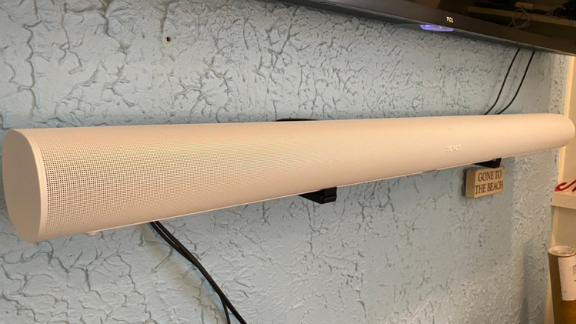
While you’re paying a hefty sum for the Sonos Arc, you’re really getting a complete package that surpasses all other soundbars we tested in terms of sound — and even most home theater systems.
Compared to the Roku Soundbar, the Sonos Arc is larger, spanning 45 inches. But the bulkier build makes sense, considering there are 11 speakers packed inside. While that’s not the most speakers we tested — the Vizio Elevate boasts 18 — the Sonos Arc is unmatched in the audio it can deliver, as it consistently delivered a crisp, detail-filled sound that was noticeably clearer than the TV’s built-in speakers.
But what truly set it apart from all the other soundbars we tested was how well it placed sounds around you for a full 360-degree audio experience. That’s thanks to the Arc’s secret sauce: TruePlay, a feature that utilizes built-in smarts to customize the audio mix for the space it’s in. During setup in the Sonos app (available for both Android and iOS), it will prompt you to complete the TruePlay process, during which the Arc will play a series of pulsating tones as the app instructs you to stand in certain positions away from the speaker — all the while the microphone on your smartphone is listening for the tone and how it sounds, collecting data from around the room where the Arc is set up. It’s listening to see how the tone is coming across, at what volume it is the most clear and if there are any echoes it should work to avoid. As a result, rather than pushing a wall of sound straight at you, this customized audio mix allows the angled speakers (pointed left, right, up and down) to push sound through the nooks and crannies of your space, immersing the room in sound to deliver a true surround-sound experience.
That custom mix’s clarity is never overwhelmed no matter how high the volume (and it can get wall-buckling loud) or how thunderous the bass the Arc can produce. And while the Roku handles spatial sound aptly, the Arc is unrivaled here, as it transplanted us back to a theater in a way no TV or soundbar could. You really feel the sound around you — if a car is racing across the screen from left to right, you feel as though it’s truly zooming by you.
More mundane or everyday content like reality TV, game shows, serials, news and documentaries also sound richer and more detailed, allowing you to hear everything to the fullest extent. Watching “Planet Earth,” for instance, main tones like the narration and backing track come through unmuddled while also introducing sounds that are normally glossed over — think animal calls in the distance or the pitter-patter of them moving. The Arc is also Dolby Atmos compatible, so for Dolby content, it will keep the audio mix true to the maker’s intent rather than compressing the audio to fit through TVs’ built-in speakers.
The Arc’s intelligence expands beyond the sound mixing too. The Arc lives within the Sonos ecosystem, so it can integrate with other connected speakers for a grouped audio experience. Additionally, the Arc features far-field microphones, which make it a very large smart speaker. Soundbars from Bose also feature this, but many others we tested did not have the smart assistant function built directly in. Sonos lets you pick between Amazon Alexa or the Google Assistant. AirPlay 2 is a great solution if you’re in the Apple ecosystem, as you can cast content to the Arc right from your device.
At $799, the Sonos Arc is not cheap and sits in the upper echelon of soundbars. But for its price, you’re getting a soundbar that produces audiophile-like sound quality.
After combing through editorial reviews, customer reviews and spec sheets, we decided on our testing pool of 18 soundbars.
With each soundbar, we paid close attention from the moment the box arrived, noting how protected the soundbar and accessories were. We timed how long the setup took and how clear the instructions were. Additionally, we paid close attention to what was included in the box. And if there was an app available, we tested it on multiple devices.
Each soundbar was tested with a range of TV models, including the Hisense ULED, LG CX, Samsung Sero, Sony X800H, Sony X900H, Sony X950H, Sony A8H, TCL 5-Series, TCL 6-Series, TCL 8-Series, Vizio V-Series, Vizio M-Series, Vizio P-Series and Vizio OLED, among others, to ensure compatibility across models.
When it comes to sound quality we tested with an array of content that spanned all genres of TV shows, movies and music. We tested with a broad range of content, including “Avengers: Endgame”; “The Mandalorian”; “WandaVision”; “Hamilton”; “Star Wars: The Rise of Skywalker”; “Frozen II”; “Tangled”; “Wreck-It Ralph”; “Space Force”; “The Bold Type”; “Below Deck”; “90 Day Fiancé”; CNN and CNN International; “The Love Guru”; Austin Powers, James Bond and Iron Man movies; “Batman v Superman: Dawn of Justice”; “Letter to You”; “Springsteen on Broadway”; “Brooklyn Nine-Nine”; “The Office”; “Wonder Woman 1984”; and countless others. We analyzed the sound via histogram and with measuring volumes that the soundbar could produce.
While the soundbar was in use, we noted if the bar itself was rocking or rattling. If the soundbar featured a microphone, we looked to see what it could be used for. In addition to standard connectivity like Bluetooth and Wi-Fi, we also tested casting technologies like Google Cast and Apple AirPlay 2.
Lastly, as we always do, we paid close attention to the warranty of each soundbar and what it covers.
Each soundbar received a total score composed of the categories and subcategories listed below.
- Sound quality had a maximum of 40 points: overall (10 points), soundstage (5 points), bass (5 points), low (5 points), mid (5 points), high (5 points) and standards (5 points).
- Smarts and connectivity had a maximum of 25 points: standards (15 points) and assistants (10 points).
- Design and appeal had a maximum of 15 points: material design (10 points) and buttons (5 points).
- Setup had a maximum of 15 points: overall setup and instructions (10 points) and packaging (5 points)
- Warranty had a maximum of 5 points: overall (5 points).
Bose 700 Soundbar ($799.95; bose.com)
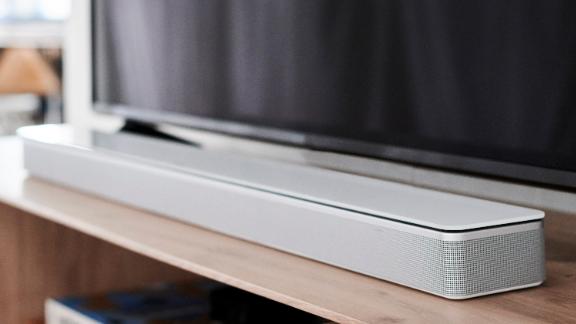
The Bose 700 Soundbar represents the high end of Bose’s lineup. At $799.95, the 700 soundbar is the same price as our winner, the Sonos Arc. In our opinion, it has one of the most aesthetically appealing designs of any soundbar we tested — a combination of glass and metal available in black or white.
Powering the audio experience is a central tweeter and four drivers that produce a very balanced sound out of the box. Bass is strong but not bouncy or directly emphasized in the mix. Similarity, mids, highs and treble come through clearly. It’s a distortion-free experience that focuses on providing clarity with room to hear each tone. It sounded great, but it didn’t get as loud or as detailed as the Sonos Arc.
Microphones are built in, and you get your pick of a smart assistant — either Amazon Alexa or the Google Assistant. You’ll control the experience with the Bose Music application for Android or iOS, but it’s not as seamless as the Sonos ecosystem. In fact, the app complicated things a bit in our testing, with slow connections and some features not always working.
Enclave CineHome II ($998; amazon.com)
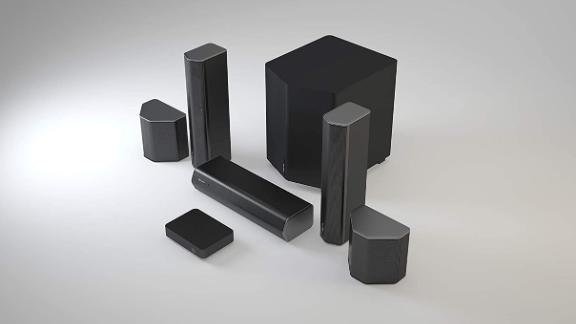
The Enclave CineHome II is an impressive kit that’s more like a complete home theater setup than a soundbar. Included in each box is a white glove — yes, a white glove to keep your fingerprints off of each speaker and components. Our favorite aspect of the CineHome II is that it’s completely wireless (well, other than the power cables). But you’re free to place the six speakers wherever they fit into your room without worrying about wires.
There’s a central control box that they all connect to, and you can use the Enclave app on your phone to adjust and fine-tune the system. You don’t need to use the app, though, as the CineHome II connects to the eARC HDMI port on your TV, which allows it to use your TV’s volume changes to adjust its volume. It’s also one of the first sound systems to be Roku TV Ready, meaning you can use your Roku TV to set up and fine-tune Enclave directly in Roku’s interface.
Overall sound quality for the CineHome II is fantastic, offering a wide soundstage while streaming everyday shows like “Gold Rush” on Discovery, YouTube videos or the movie “Soul” on Disney+.
Where the CineHome II fell a little short for us was the overall lack of bass and the need to watch shows at high volume in order to take full advantage of the sound quality. It’s a fine sound system, there’s no doubt, but it’s best designed for someone who likes watching movies with the volume cranked to 11.
Roku Streambar ($109.99, originally $129.99; amazon.com)
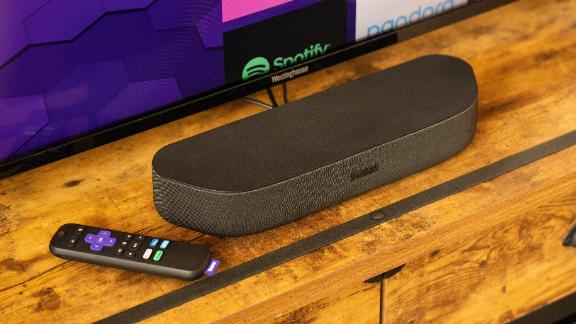
Roku’s Streambar is a smaller, more compact version of the Roku Soundbar. But don’t let its size fool you: It’s nearly just as capable. And, perhaps more importantly, it’s just $129. For that, you not only get a compact soundbar that puts out respectable sound, but you also get a full-fledged Roku streaming device. That means you can use it to watch all of your favorite shows across your favorite streaming services — in 4K, mind you — just by connecting the Streambar to your TV.
The Streambar is less than half the size of the Soundbar, and its small footprint looks funny when placed under larger (think 65-inch or bigger) TVs. The cloth surface wraps the front and sides of the Streambar, giving it the same core look as the Soundbar.
We enjoyed the sound quality of the Streambar, but it ultimately fell short of its bigger sibling. There was an obvious lack of sound missing in the center channel, leaving the left and right channels to pick up the slack and fill the room. And while it did a good job, you can score the Smart Soundbar for just a little more money and get a more optimal sound experience.
Samsung Q800T ($679.99, originally $899.99; samsung.com)

One of Samsung’s more recent combination soundbar and subwoofers is the Q800T. As the name suggests, it’s designed to be paired with the QLED family of TVs that the brand makes. The Q800T combines a soundbar with speakers set in different directions with a tall subwoofer.
Our favorite portion of the Q800T was the subwoofer. It not only grounded the mix, taking care of the low and bass tones, but it also allowed us to expand the scope of sound. It’s a wireless subwoofer and can be placed a bit farther away from the bar itself. While this subwoofer handles the lower end of the spectrum, the Q800T handles mids and highs. In other words, they complement each other quite well.
From the soundbar itself, audio is upward and front-firing through a series of speakers inside. It allows music to go above you and directly in front of you. If paired with a Samsung QLED it will even work in tandem with the TV’s internal speakers. Ultimately, though, the audio produced just wasn’t on par with the Sonos Arc.
Sonos Beam ($499; sonos.com)
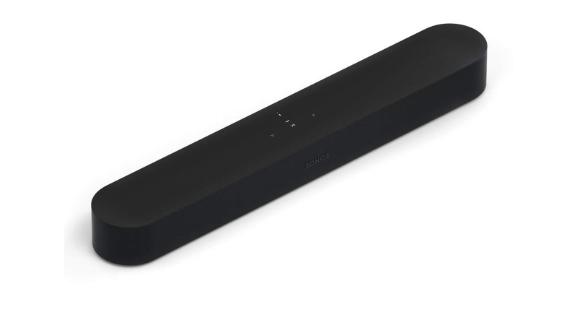
The Sonos Beam is a really terrific soundbar, and when it first launched it owned the space. But the much more affordable Roku Smart Soundbar is on par with the Sonos Beam.
They really scored very close, with only a few points accounting for the differences. The Beam produced deeper bass and could get a bit louder. But at its price point, we don’t think the device is worth several hundred more. The Roku Smart Soundbar offered many of the same audio modes, such as dialogue enhancement and the ability to reduce loud noises. Sonos did get a leg up for its customizable EQ, though.
Sony HT-S350 ($198, originally $279; amazon.com)

Sony’s entry-level HT-S350 pairs a soundbar with a wireless subwoofer in one package. It has support for many audio mixing standards — Dolby Atmos and DTSX included — but minimal smart connectivity features.
Sound was pretty average in our testing. Sony mixed clarity and extra details with loudness and crisp bass via the subwoofer. Front and center is Sony’s virtualization technology, which aims to replicate a surround sound experience with just the internals of the bar. Sony doesn’t include satellite speakers with many of its soundbars; rather, it intelligently mixes with a front-facing sound experience. Ultimately, it doesn’t quite meet the bar set by the Roku Smart Soundbar.
Sony HT-G700 ($498, originally $599; amazon.com)

Sony’s HT-G700 is a step up from the HT-S350 and really focuses on virtualization technology. It’s a standard soundbar paired with a woofer that focuses on a front-facing mix. It’s a lot better on this model than on the HT-S350, though. With just the soundbar and the subwoofer, we really felt the sound all around us.
Even with this virtualization, it does pack in support for Dolby Atmos. The subwoofer is wireless and automatically connects to the soundbar. It’s also a one-plug connection directly to the TV via HDMI. The speaker placement inside the soundbar aides in clarity with dialogue as well. At the price point, though, it falls in the middle of the road a bit.
Sony HT-Z9F ($698, originally $799; amazon.com)
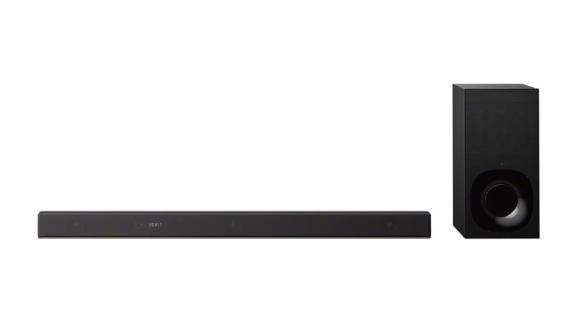
The Sony HT-Z9F performed very closely with the HT-G700 featured above. While it didn’t earn a top spot, it pairs the excellent virtualization technology with the smarts that are missing on the cheaper models. Sony’s HT-Z9F supports Amazon Alexa and the Google Assistant.
But that’s the main difference compared with the lower models. In terms of sound, we felt Sony was able to provide a mix that felt like a true surround sound setup without the need for additional satellite speakers. Audio was punchy, both from the soundbar and the subwoofer, along with vibrant pops when needed. We especially liked it, as we did with the Sonos Arc, for superhero and epic action movies. The immersion was evident, but the Sonos Arc delivered a better package at the same core price.
Sony HT-ST5000 ($1,198, originally $1,498; amazon.com)

Out of all the soundbars we tested, Sony’s HT-ST5000 was the most expensive, but it ultimately delivered a middle-of-the-road sound experience. In fact, we prefer the Sony HT-G700 out of any of the Sony soundbars that we tested. The Sonos Arc performs better and proves that less is more — both in terms of budget and with hardware.
The audio, produced by a soundbar and a wireless subwoofer, didn’t sound as detailed or vibrant as the Sonos Arc; it lacked a punch in terms of quality and clarity. Like the other Sony offerings, it does feature virtual surround sound, but it felt muddier and lacked the soundstage that we saw from cheaper models and other brand names.
Vizio V-Series 5.1 ($199.99, originally $249.99; bestbuy.com)
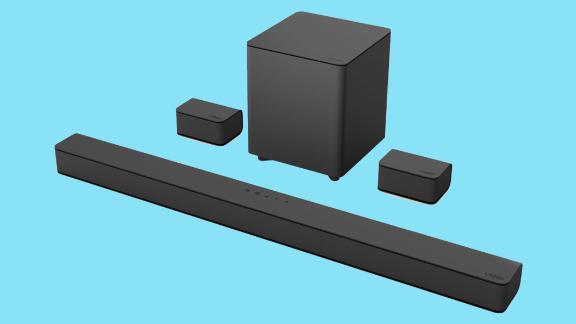
Complete with a soundbar, two satellite speakers and a subwoofer, the V-Series 5.1 was on par with the Roku Soundbar and adds in a bit more bass but at a higher price point.
The soundbar itself features three speakers that act as the center of the mix. On its own, it gives you increased volume, but dialogue can end up getting washed out with other noises in the mix. Additionally, the V-Series 5.1 includes satellite speakers along with a modest-size subwoofer. When it’s all hooked up, you get a surround sound experience that really puts you in the center of the action. And with Dolby Atmos content, the V-Series intelligently reads the instructions for a better mix.
Considering this device’s price, it’s a really solid home theater setup — but we think for the money and for the simplicity, Roku’s Smart Soundbar is a better deal all around.
Vizio M-Series Soundbar ($128, originally $149.99; amazon.com)
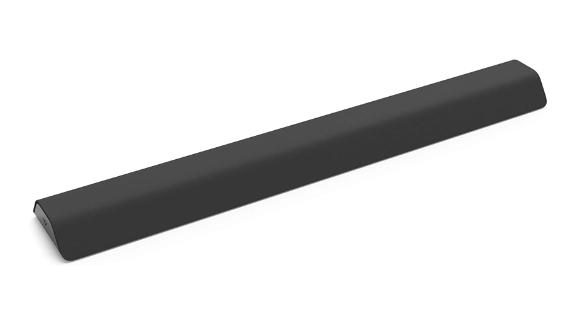
Even more entry level than Vizio’s V-Series is the M-Series soundbar. It’s seriously a bare-bones soundbar setup, providing a basic sound louder than what’s built into your TV but leaving us wanting more in the realm of clarity and bass.
From first looks, the M-Series is a simple soundbar with a sloped front. It’s also pretty thin for a soundbar, which had us questioning space for sound to be pushed out from the six speakers inside. That’s an impressive number of speakers in a soundbar at this price, and they work well to really up overall potential volume. It’s a noticeable improvement over TV speakers but only brings marginal improvements with clarity among voices and with bass.
Vizio Elevate ($979.99; amazon.com)

The Vizio Elevate boasts 18 speakers. The left and right ends of the soundbar can strategically rotate up to be upward-firing or stay forward-facing for a wide soundstage. It’s seriously impressive and gives us a taste at what future home entertainment audio might look like.
It’s not just a one-and-done package, though. The Elevate soundbar is paired with a modest-size subwoofer and two satellite speakers. And you really need to set it all up for a truly compelling experience.
And while it does support HDMI eARC for easy setup, it is missing some key connectivity points. It supports Google Cast, but Apple AirPlay 2 isn’t supported here. There are no microphones on board, either.
Read more from CNN Underscored’s hands-on testing:
